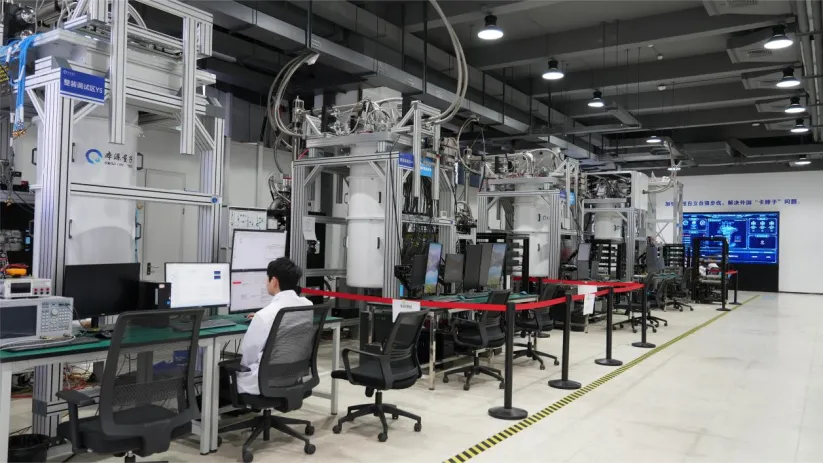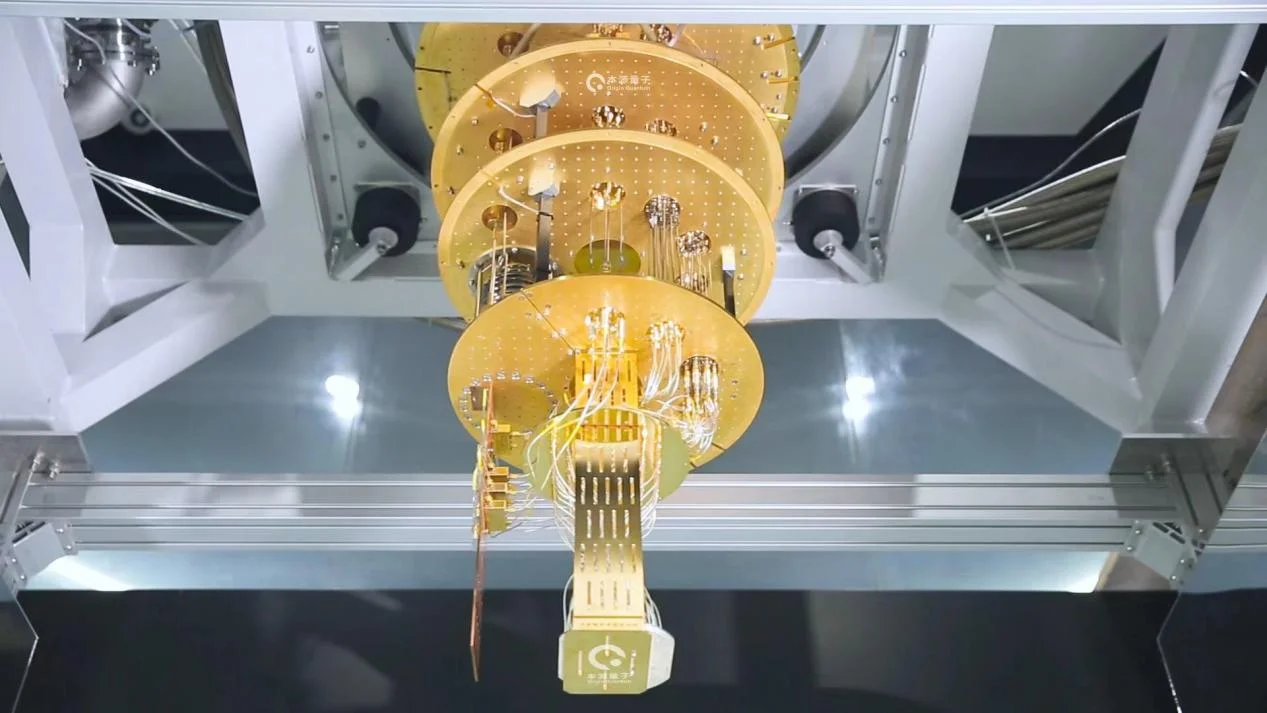The post China’s Quantum Computer Set to Expand Its Lead on Hypersonic Missiles first appeared on China Academy.
]]>Computational fluid dynamics (CFD) is crucial in aerospace, automotive, and shipbuilding, significantly impacting the design of aircraft, vehicles, and vessels. Increased computing power accelerates product development cycles and reduces design costs. However, traditional supercomputers struggle to meet the growing demands for computational scale, precision, and speed.
 China’s third-generation independently developed superconducting quantum computer, “Origin Wukong,” along with several other quantum computers.
China’s third-generation independently developed superconducting quantum computer, “Origin Wukong,” along with several other quantum computers.
Quantum computing offers a powerful alternative for CFD. Compared to classical methods, it promises to dramatically accelerate fluid dynamics simulations, substantially reducing development time and costs.
In a remarkable convergence of quantum computing and fluid dynamics, researchers from Origin Quantum Computing Technology (Hefei) Co., Ltd., as well as University of Science and Technology of China, have unveiled an innovative method that harnesses the power of quantum computers to revolutionize the world of computational fluid dynamics (CFD) and conducted the simulation at the largest scale to date (solving a 5043-dimensional matrix). This approach, detailed in a recent paper published in the journal Computer Methods in Applied Mechanics and Engineering, promises to unlock new frontiers in fields ranging from aerospace engineering to climate modeling.
 Origin Quantum – Wukong Quantum Computer
Origin Quantum – Wukong Quantum Computer
The crux of the matter lies in the inherent limitations of classical supercomputers, which are rapidly reaching their performance limits as they approach the atomic scale of transistors. This predicament has spurred the exploration of quantum computing, a paradigm shift in information processing that leverages the extraordinary principles of quantum mechanics.
Predicting the fluid dynamic at high speed accurately is a monumental task, akin to assembling a gigantic jigsaw puzzle with millions of pieces—a challenge traditional supercomputers tackle by solving enormous equations describing wind, temperature, and pressure.
In contrast, this new quantum method offers a radically improved, faster puzzle-solving machine. Its innovation rests on two key components: Iterative-QLS, a precision-tuning process that repeatedly corrects for the inherent errors in current quantum computers, much like carefully adjusting warped jigsaw pieces to create a sharp image; and the subspace method, which simplifies the massive complexity of fluid flow by dividing the problem into smaller, manageable chunks, analogous to breaking the fluid dynamic puzzle into smaller regional ones, solving each individually, and then combining the solutions for a complete, high-resolution picture.


The team successfully tested this approach on two classic fluid flow scenarios: steady Poiseuille flow (smooth fluid flow through a pipe, achieving over 99.8% accuracy), and unsteady acoustic wave propagation (simulating sound wave ripples, handling a staggering 5043-dimensional problem, demonstrating impressive scalability).
These breakthroughs hold the potential to revolutionize a wide range of industries and disciplines. In aerospace engineering, for instance, more accurate simulations of airflow around aircraft and rockets could lead to the development of faster, more fuel-efficient designs. Similarly, the automotive industry could benefit from optimized engine and aerodynamic simulations, paving the way for greener, high-performance vehicles.
Beyond transportation, the implications extend to weather forecasting, where quantum CFD could significantly improve the accuracy and lead time of predictions, aiding in disaster preparedness and mitigation. In the medical field, simulating blood flow within the human body could provide invaluable insights for the diagnosis and treatment of cardiovascular diseases. And in the realm of climate modeling, quantum computing could enhance the precision and speed of simulations, crucial for understanding and addressing the pressing challenge of climate change.
The post China’s Quantum Computer Set to Expand Its Lead on Hypersonic Missiles first appeared on China Academy.
]]>The post Online Shopping Will Be Secured by Quantum Mechanics first appeared on China Academy.
]]>To address this issue, scientists have turned to quantum cryptography, a branch of quantum mechanics that offers information-theoretic security against adversaries. Chinese scientists from Nanjing University have made a significant breakthrough in this field by developing a quantum e-commerce scheme that provides unprecedented security measures. This research, published in the journal Science Advances, not only holds the potential to revolutionize online transactions but also offers a practical solution to protect sensitive information in daily life.

Quantum Key Distribution (QKD) is the most well-known application of quantum technology in ensuring secure communication. It provides remote users with unconditionally secure encryption keys, guaranteeing the confidentiality of messages. However, existing quantum solutions often suffer from lower performance compared to classical methods, especially when imperfect devices are involved.
The scientists from Nanjing have successfully demonstrated a quantum e-commerce scheme that enables the signing of contracts and secure payments among three parties. They have looked at a real-world situation where the merchant and client need to complete a transaction and reach an agreement. To help with this, they introduce a third party to help with the process. Unlike in the classical setup, where third parties are usually trusted by default, here the scientists don’t make any assumptions about them. They have taken the Amazon Web Services Customer Agreement, which is 428,072 bits long, to demonstrate the underlying principles of the process.
In this three-party scenario, a client is buying a product from a merchant. A third party acts as an arbiter to prevent either the merchant or the client from cheating. The merchant shares two sequences of coherent quantum states with the client and third party, respectively.
The merchant then generates the contract with all the information about the e-commerce and gets a signature through a hash function and keys distilled from his sequences. After that, the merchant sends the contract and signature to the client.
 schematic of the quantum e-commerce protocol
schematic of the quantum e-commerce protocol
If the client agrees with the contract, he sends the contract, signature, and keys distilled from his sequence to the third party. The third party then sends keys distilled from his own sequence back to the client.
Both the client and third party independently verify the signature using their own keys and the received keys by using hash functions. If the client verifies the signature, he pays the money to the third party. The third party then transfers the money to the merchant if he also passes the signature verification.
Overall, this innovative scheme overcomes the limitations posed by imperfect devices and showcases remarkable resistance to attacks. The research team achieved a signature rate of 0.82 times per second for an agreement size of approximately 0.428 megabits, even with a significant attenuation of up to 25 decibels among participants. By integrating quantum digital signatures (QDS), which provide information-theoretic security, the new scheme ensures the integrity, authenticity, and non-repudiation of messages in e-commerce transactions.
The significance of this breakthrough extends beyond the realm of scientific research. As online transactions continue to dominate the global market, the need for secure and reliable e-commerce platforms becomes paramount. The Chinese scientists’ quantum e-commerce scheme presents a promising solution by leveraging the power of quantum mechanics to enhance the security of online transactions.
With the implementation of this scheme, users can have increased confidence in the integrity of their transactions, knowing that their information remains secure against computational attacks. By providing information-theoretic security, the scheme offers an advanced level of protection, significantly surpassing the capabilities of traditional cryptographic algorithms.Looking ahead, the successful implementation of quantum e-commerce could revolutionize the way we conduct online transactions, providing a secure and efficient framework for businesses and consumers alike. It has the potential to create a new paradigm in secure online trading, protecting valuable data and ensuring trust among participants.
The post Online Shopping Will Be Secured by Quantum Mechanics first appeared on China Academy.
]]>